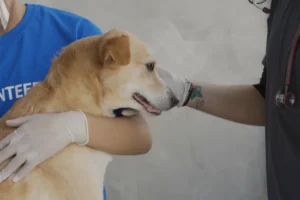Many people have noticed a concerning trend: an increasing number of cats are missing eyes. But why is this happening? The answer isn’t as straightforward as you might think.
Feline Eye Injuries: Common Causes and Treatments
Feline eye injuries can result from various factors, such as accidents, fights with other animals, or even medical conditions like infections. These injuries can be distressing for both the cat and the owner, but prompt treatment is crucial to prevent further complications.
If your cat is experiencing eye injury symptoms like swelling, discharge, or squinting, it’s essential to seek veterinary care immediately. A veterinarian will assess the injury and recommend appropriate treatment, which may include medication, surgery, or even eye removal in severe cases.
Prevention is key to reducing the risk of feline eye injuries. Ensure your cat’s environment is safe, free of hazards that could potentially cause harm. Regular veterinary check-ups can also help catch any eye issues early on.
Remember, an eye injury in cats should never be ignored. Seeking prompt veterinary care can make all the difference in your cat’s recovery and overall well-being.
Genetics and Eye Abnormalities in Cats
Genetics can play a significant role in eye abnormalities seen in cats, including congenital conditions that may lead to cats being born without eyes. Congenital conditions are present at birth and can result from genetic mutations or developmental issues during fetal growth.
Certain cat breeds may be more prone to genetic eye abnormalities, such as Persian cats with a higher risk of cherry eye. These abnormalities can impact a cat’s vision and overall quality of life, highlighting the importance of responsible breeding practices.
As a cat owner, it’s essential to be aware of any breed-specific risks for eye abnormalities and discuss them with your veterinarian. Early detection and intervention can help manage these conditions effectively and improve your cat’s long-term eye health.
Understanding the genetic factors behind eye abnormalities in cats can empower you to provide the best possible care for your feline friend, ensuring they live a happy and healthy life.
The Impact of Neglect and Abuse on Feline Health
Neglect and abuse can have devastating effects on a cat’s health, often leading to serious injuries such as eye trauma that can result in the loss of an eye. Cats that are subject to neglect may not receive proper medical care when they are injured, allowing their condition to worsen over time. Similarly, cats that are abused may suffer physical harm, including eye injuries, due to intentional harm inflicted upon them.
To prevent these heartbreaking situations, it is crucial for cat owners to provide a safe and loving environment for their feline companions. Regular veterinary check-ups can help detect potential health issues early on, including eye problems. If you suspect your cat has been injured or is unwell, seek veterinary care immediately to prevent further complications.
Additionally, educating yourself and others on the importance of responsible pet ownership can help prevent cases of neglect and abuse. By raising awareness and promoting animal welfare, we can work together to ensure that all cats receive the love and care they deserve.
Feline Eye Diseases: Diagnosis and Management
Cats, like humans, can suffer from a variety of eye diseases that can impact their vision and overall health. Common eye conditions in cats include conjunctivitis, glaucoma, and cataracts, among others. These diseases can be diagnosed through a thorough eye examination by a veterinarian, which may include tests such as eye pressure measurements and tear production assessments.
Once diagnosed, the management of feline eye diseases typically involves a combination of medication, surgery, or other medical interventions, depending on the specific condition. It is important to follow your veterinarian’s treatment recommendations and attend regular follow-up appointments to monitor your cat’s progress.
In addition to seeking professional veterinary care, there are steps cat owners can take to promote good eye health in their feline companions. Regularly cleaning your cat’s eyes with a damp cloth can help prevent eye infections, while providing a balanced diet rich in essential nutrients can support overall eye health.
Common Feline Eye Diseases: 1. Conjunctivitis 2. Glaucoma 3. Cataracts 4. Corneal ulcer
Remember, early detection and prompt treatment are key to managing feline eye diseases effectively. By staying proactive and attentive to your cat’s eye health, you can help ensure a bright and healthy future for your furry friend.
Prosthetic Eyes for Cats: A Closer Look
Have you ever wondered why so many cats are missing eyes? It’s a heartbreaking sight, but there is hope in the form of prosthetic eyes. Prosthetic eyes for cats who have lost an eye can be a game-changer. These specially designed artificial eyes not only restore the appearance of the missing eye but also help protect the socket and prevent infections.
The benefits of prosthetic eyes for cats are numerous. Firstly, they can improve the cat’s quality of life by restoring their appearance and boosting their self-esteem. Additionally, prosthetic eyes can prevent the surrounding tissue from collapsing, which can help maintain the eye socket’s shape. Moreover, these artificial eyes are custom-made to fit each cat perfectly, ensuring a comfortable and secure fit.
When considering prosthetic eyes for your feline friend, it’s essential to consult with a veterinarian who specializes in ophthalmology. They can assess your cat’s condition, discuss the procedure in detail, and provide guidance on the best course of action. It’s vital to weigh the benefits and considerations of this procedure carefully before making a decision.
It’s worth noting that prosthetic eyes are not suitable for every cat, so veterinary guidance is crucial. Remember, your cat’s well-being is the top priority, so always consult with professionals to ensure the best outcome.
The Importance of Veterinary Care for Feline Eye Health
When it comes to understanding why so many cats are missing eyes, regular veterinary check-ups play a critical role. These routine visits are essential for maintaining your cat’s eye health and catching potential issues early. Eye problems can escalate quickly if left unattended, potentially leading to serious complications and even the loss of an eye.
During veterinary check-ups, your veterinarian will examine your cat’s eyes for any signs of disease, injury, or infection. Early detection of eye problems is key to preventing long-term damage and ensuring prompt treatment. Additionally, regular check-ups allow veterinarians to monitor your cat’s overall health and catch any underlying issues that may be affecting their eyes.
To support your cat’s eye health between vet visits, make sure to monitor their eyes for any changes in appearance or behavior. Look out for symptoms such as redness, discharge, squinting, or cloudiness, as these could indicate a problem that requires immediate attention.
Remember, proactive veterinary care is the foundation of a healthy and happy cat. By staying vigilant and prioritizing your cat’s eye health, you can help prevent the need for drastic measures like prosthetic eyes and ensure your feline companion enjoys a lifetime of clear vision.
Tips for Preventing Eye Injuries in Cats
Cats are known for their curiosity and agility, but these traits can sometimes put them at risk for eye injuries. To help keep your feline friend safe and sound, here are some practical tips to prevent eye injuries:
- Keep hazardous objects out of reach: Cats love to play with small objects that can easily injure their eyes, such as sharp toys or small pieces of string. Make sure to keep these items out of their reach to prevent accidents.
- Regular grooming: Keep your cat’s fur around their eyes clean and trimmed to prevent irritation or infections that could lead to eye injuries.
- Invest in safe toys: Choose toys that are specifically designed for cats and avoid any that have sharp edges or small parts that could harm their eyes.
- Ensure a safe environment: Check your home for any potential hazards that could cause eye injuries, such as exposed wires or sharp edges. Make adjustments to create a safe environment for your cat to roam freely.
- Regular vet check-ups: Visit your veterinarian regularly to check your cat’s overall eye health and catch any potential issues early on.
By following these tips, you can help reduce the risk of eye injuries in your beloved feline companion and ensure they live a happy and healthy life.
Coping with a Cat Who Has Lost an Eye: Emotional Support and Practical Tips
Losing an eye can be a challenging experience for a cat, but with the right support and care, they can still lead a fulfilling life. Here are some ways to provide emotional support and practical tips for a cat who has lost an eye:
- Provide a safe and comfortable space: Create a cozy environment for your cat to feel secure and relaxed after losing an eye. Offer soft bedding and comforting toys to help them adjust.
- Maintain a routine: Stick to a consistent feeding schedule and playtime routine to provide stability and comfort for your cat during this transition.
- Monitor their behavior: Keep an eye on your cat’s behavior and activity level to ensure they are adapting well to their newfound situation. Seek veterinary help if you notice any concerning changes.
- Be patient and understanding: Give your cat time to adjust to their new circumstances and provide plenty of love and affection to reassure them that they are still valued and cared for.
With patience, love, and proper care, you can support your cat through this challenging time and help them continue to live a happy and healthy life.
Alex, a passionate animal lover, has experience in training and understanding animal behavior. As a proud pet parent to two dogs and three cats, he founded AnimalReport.net to share insights from animal experts and expand his knowledge of the animal kingdom.




